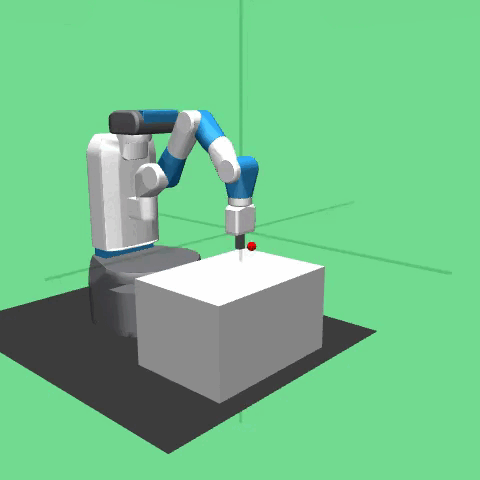Reach#

Description#
This environment was introduced in “Multi-Goal Reinforcement Learning: Challenging Robotics Environments and Request for Research”.
The task in the environment is for a manipulator to move the end effector to a randomly selected position in the robot’s workspace. The robot is a 7-DoF Fetch Mobile Manipulator with a two-fingered parallel gripper. The robot is controlled by small displacements of the gripper in Cartesian coordinates and the inverse kinematics are computed internally by the MuJoCo framework. The task is also continuing which means that the robot has to maintain the end effector’s position for an indefinite period of time.
The control frequency of the robot is of f = 25 Hz. This is achieved by applying the same action in 20 subsequent simulator step (with a time step of dt = 0.002 s) before returning the control to the robot.
Action Space#
The action space is a Box(-1.0, 1.0, (4,), float32). An action represents the Cartesian displacement dx, dy, and dz of the end effector. In addition to a last action that controls closing and opening of the gripper. This last action is not required since
there is no object to be manipulated, thus its value won’t generate any control output.
Num |
Action |
Control Min |
Control Max |
Name (in corresponding XML file) |
Joint |
Unit |
|---|---|---|---|---|---|---|
0 |
Displacement of the end effector in the x direction dx |
-1 |
1 |
robot0:mocap |
hinge |
position (m) |
1 |
Displacement of the end effector in the y direction dy |
-1 |
1 |
robot0:mocap |
hinge |
position (m) |
2 |
Displacement of the end effector in the z direction dz |
-1 |
1 |
robot0:mocap |
hinge |
position (m) |
3 |
- |
-1 |
1 |
- |
- |
- |
Observation Space#
The observation is a goal-aware observation space. It consists of a dictionary with information about the robot’s end effector state and goal. The kinematics observations are derived from Mujoco bodies known as sites
attached to the body of interest, the end effector. Also to take into account the temporal influence of the step time, velocity values are multiplied by the step time dt=number_of_sub_steps*sub_step_time. The dictionary consists of the following 3 keys:
observation: its value is anndarrayof shape(10,). It consists of kinematic information of the end effector. The elements of the array correspond to the following:
Num |
Observation |
Min |
Max |
Site Name (in corresponding XML file) |
Joint Name (in corresponding XML file) |
Joint Type |
Unit |
|---|---|---|---|---|---|---|---|
0 |
End effector x position in global coordinates |
-Inf |
Inf |
robot0:grip |
- |
- |
position (m) |
1 |
End effector y position in global coordinates |
-Inf |
Inf |
robot0:grip |
- |
- |
position (m) |
2 |
End effector z position in global coordinates |
-Inf |
Inf |
robot0:grip |
- |
- |
position (m) |
3 |
Joint displacement of the right gripper finger |
-Inf |
Inf |
- |
robot0:r_gripper_finger_joint |
hinge |
position (m) |
4 |
Joint displacement of the left gripper finger |
-Inf |
Inf |
- |
robot0:l_gripper_finger_joint |
hinge |
position (m) |
5 |
End effector linear velocity x direction |
-Inf |
Inf |
robot0:grip |
- |
- |
velocity (m/s) |
6 |
End effector linear velocity y direction |
-Inf |
Inf |
robot0:grip |
- |
- |
velocity (m/s) |
7 |
End effector linear velocity z direction |
-Inf |
Inf |
robot0:grip |
- |
- |
velocity (m/s) |
8 |
Right gripper finger linear velocity |
-Inf |
Inf |
- |
robot0:r_gripper_finger_joint |
hinge |
velocity (m/s) |
9 |
Left gripper finger linear velocity |
-Inf |
Inf |
- |
robot0:l_gripper_finger_joint |
hinge |
velocity (m/s) |
desired_goal: this key represents the final goal to be achieved. In this environment it is a 3-dimensionalndarray,(3,), that consists of the three cartesian coordinates of the desired final end effector position[x,y,z]. The elements of the array are the following:
Num |
Observation |
Min |
Max |
Site Name (in corresponding XML file) |
Unit |
|---|---|---|---|---|---|
0 |
Final goal end effector position in the x coordinate |
-Inf |
Inf |
robot0:grip |
position (m) |
1 |
Final goal end effector position in the y coordinate |
-Inf |
Inf |
robot0:grip |
position (m) |
2 |
Final goal end effector position in the z coordinate |
-Inf |
Inf |
robot0:grip |
position (m) |
achieved_goal: this key represents the current state of the end effector, as if it would have achieved a goal. This is useful for goal orientated learning algorithms such as those that use Hindsight Experience Replay (HER). The value is anndarraywith shape(3,). The elements of the array are the following:
Num |
Observation |
Min |
Max |
Site Name (in corresponding XML file) |
Unit |
|---|---|---|---|---|---|
0 |
Current end effector position in the x coordinate |
-Inf |
Inf |
robot0:grip |
position (m) |
1 |
Current end effector position in the y coordinate |
-Inf |
Inf |
robot0:grip |
position (m) |
2 |
Current end effector position in the z coordinate |
-Inf |
Inf |
robot0:grip |
position (m) |
Rewards#
The reward can be initialized as sparse or dense:
sparse: the returned reward can have two values:
-1if the end effector hasn’t reached its final target position, and0if the end effector is in the final target position (the robot is considered to have reached the goal if the Euclidean distance between the end effector and the goal is lower than 0.05 m).dense: the returned reward is the negative Euclidean distance between the achieved goal position and the desired goal.
To initialize this environment with one of the mentioned reward functions the type of reward must be specified in the id string when the environment is initialized. For sparse reward the id is the default of the environment, FetchReach-v2. However, for dense
reward the id must be modified to FetchReachDense-v2 and initialized as follows:
import gymnasium as gym
env = gym.make('FetchReachDense-v2')
Starting State#
When the environment is reset the gripper is placed in the following global cartesian coordinates (x,y,z) = [1.3419 0.7491 0.555] m, and its orientation in quaternions is (w,x,y,z) = [1.0, 0.0, 1.0, 0.0]. The joint positions are computed by inverse kinematics
internally by MuJoCo. The base of the robot will always be fixed at (x,y,z) = [0.405, 0.48, 0] in global coordinates.
The gripper’s target position is randomly selected by adding an offset to the initial grippers position (x,y,z) sampled from a uniform distribution with a range of [-0.15, 0.15] m.
Episode End#
The episode will be truncated when the duration reaches a total of max_episode_steps which by default is set to 50 timesteps.
The episode is never terminated since the task is continuing with infinite horizon.
Arguments#
To increase/decrease the maximum number of timesteps before the episode is truncated the max_episode_steps argument can be set at initialization. The default value is 50. For example, to increase the total number of timesteps to 100 make the environment as follows:
import gymnasium as gym
env = gym.make('FetchReach-v2', max_episode_steps=100)
Version History#
v2: the environment depends on the newest mujoco python bindings maintained by the MuJoCo team in Deepmind.
v1: the environment depends on
mujoco_pywhich is no longer maintained.


